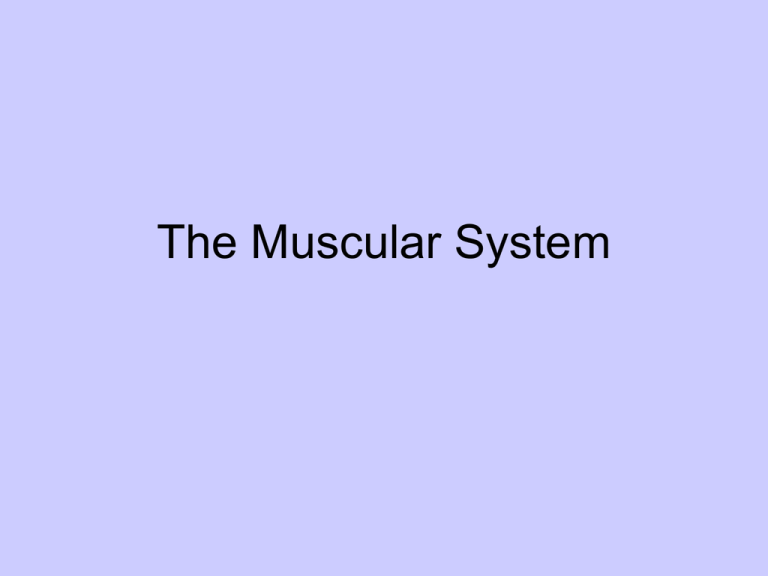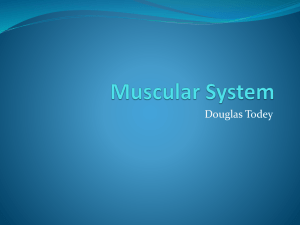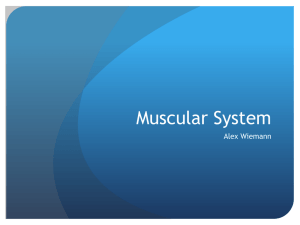The Muscular System
advertisement

The Muscular System Characteristics of Muscle Tissue • Contractility- the ability to shorten and thicken • Excitability – ability of muscle tissue to receive and respond to stimuli • Extensibility – ability of the muscle to stretch • Elasticity – the ability of the muscle tissue to return to its original shape after contraction 3 Types of Muscle Tissue: • • • Smooth – located in walls of hollow internal structures, non-striated, involuntary Skeletal – attached mostly to bone, striated, voluntary Cardiac – found in the heart, striated, involuntary Anatomy of Skeletal Muscle Key Terms: • Muscle fiber – muscle cell • Epimysium – conn. tissue surrounding entire muscle • Perimysium – conn. tissue surrounding fascicles • Fascicle – bundle of muscle fibers (cells) • Endomysium – conn. tissue surrounding individual fibers Skeletal Muscle Cells – Muscle cell = muscle fiber – Contains many nuclei and mitochondria – Each muscle fiber contains many myofibrils – threadlike protein filaments – 2 types: • Myosin – thick filaments • Actin – thin filaments • Organization of these produces striations charac. of skeletal muscle tissue Sarcomere Key Terms: • actin (thin filaments) • myosin (thick filaments) • A band – dark band made up of thick filaments • M line – dark line in center of A band • I band – light band made up of thin filaments • Z line – mark boundary between sarcomeres Sarcomere: the functional contractile unit of muscle Sliding Filament Theory • Myosin – protein strands with globular parts called cross-bridges • Actin – protein strands with binding sites where myosin cross-bridges can attach; binding site protected by troponin and tropomyosin • Ca+ moves troponin and tropomyosin out of the way so cross bridges can bind. • Cross-bridges (myosin) bind to actin and produce a powerstroke (myosin cross-bridges pull actin toward H zone) • ATP releases the myosin. IT DOES NOT PRODUCE THE POWERSTROKE • Cross-bridges release and attach to new binding site on actin, and whole process begins again; will continue as long as calcium and ATP are available 5 steps to muscle contraction 1. Ca+ is released in large amounts 2. Ca+ moves troponin and tropmyosin out of way of myosin (so it can grab actin) 3. Myosin grabs actin and pulls it in 1 step 4. ATP causes myosin to release actin 5. Steps 3 & 4 are repeated until; A. muscle can no longer contract any further. B. nerve impulse ends causing muscle relaxation. 3 Steps from nerves to muscles 1. Nerve impulse comes from brain to activate muscle 2. At the end of the nerve Acetylcholine is released into gap between muscle and nerve (neuromuscular junction). 3. Acetylcholine causes the release of Ca+ Summary of Muscle Contraction 6 Steps of Muscle Relaxation 1. Nerve impulse stops 2. Acetylcholine is no longer released at neuromuscular junction 3. Calcium ions are removed 4. Without Ca+ Troponin and tropomyosin go back to blocking myosin from grabbing actin. 5. ATP causes linkage between myosin and actin to break 6. Muscle fibers relax Rigor Mortis • When a person dies they release Ca+ causing their muscle to contract. • This also causes the use of ATP • However, the body is no longer producing ATP so the myosin cross bridges can not release. • This causes the muscles to stay contracted and the body to feel stiff. Energy Sources for Contraction • ATP supplies the energy for muscle fiber contraction, which lasts only a few seconds. ATP must be regenerated continuously if the contraction is to continue. • There are 3 pathways in which ATP is regenerated: • 1. Creatine phosphate, found in muscle fibers, stores energy that can be used to synthesize ATP from ADP and phosphate (uses no oxygen); runs out fast Cont: • 2. Aerobic Respiration: glucose is broken down to supply ATP (oxygen is required). • Yields 36 ATP • 3. Anaerobic Respiration – glucose is broken down not in the presence of Oxygen • This yields 2 ATP.








